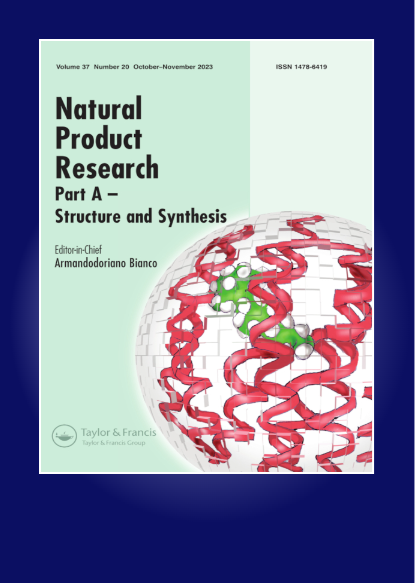具有潜在抗真菌活性的一种不寻常的 2-O-甘油-糖基-γ-吡喃酮:体外和微观研究。
IF 1.6
3区 化学
Q3 CHEMISTRY, APPLIED
引用次数: 0
摘要
通过对黄柏提取物极性部分的植物化学特性分析,分离出了一种独特的γ-吡喃酮衍生物--甘油黄柏苷(1)。通过对核磁共振和质谱的深入研究,确定了 1 的结构为 3-O-[4'-((1,3-二羟基丙-2-基)氧基)-β-D-吡喃葡萄糖苷)]-4H-吡喃-4-酮,其不常见的甘油氧侧链连接在吡喃酮酸 β-D 吡喃葡萄糖苷的 4'位置。测试了 1 对金黄色葡萄球菌、肠炎沙门氏菌和白色念珠菌的抗菌潜力。与氟康唑(MIC = 16.33 µM/盘)相比,化合物 1 能强烈抑制白色念珠菌的生长(MIC = 17.24 µM/盘)。同时,与噻吩酚(MIC = 14.05 µM/disc)和(MIC = 14.05 µM/disc)相比,它分别能中度抑制金黄色葡萄球菌(MIC = 71.84 µM/disc)和肠炎沙门氏菌(MIC = 71.84 µM/disc)的生长。分子对接研究预测了 1 与白念珠菌固醇 14α-demethylase (CYP51)(PDB ID:5TZ1)活性位点的结合模式,并支持其与氟康唑联用的抗真菌活性。本文章由计算机程序翻译,如有差异,请以英文原文为准。
An unusual 2-O-glyceryl-glycosyl-γ-pyrone from Erigeron annuus (L.) with potential antifungal activity: in-vitro and in-silico study
Phytochemical characterisation of the polar fraction of Erigeron annuus extract led to the isolation of glycerylerigeroside (1), a unique γ-pyrone derivative. Structure of 1 was decided by intensive study of NMR and mass spectra as 3-O-[4'-((1,3-dihydroxypropan-2-yl)oxy)-β-D-glucopyranoside)]-4H-pyran-4-one, with uncommon glyceroxy side chain attached to 4’ position of pyromeconic acid β-D-glucopyranoside. Antimicrobial potential of 1 was tested against Staphylococcus aureus, Salmonella enterica, and Candida albicans. Compound 1 strongly inhibited growth of Candida albicans (MIC = 17.24 µM/disc), compared to fluconazole (MIC = 16.33 µM/disc). Meanwhile, it moderately inhibited the growth of Staphylococcus aureus (MIC = 71.84 µM/disc) and Salmonella enterica (MIC = 71.84 µM/disc), as compared with thiophenicol (MIC = 14.05 µM/disc) and (MIC = 14.05 µM/disc), respectively. The binding mode of 1 with the active site of sterol 14α-demethylase (CYP51) from Candida albicans (PDB ID: 5TZ1), in combination with fluconazole, was predicted by molecular docking study and supported the antifungal activity.
求助全文
通过发布文献求助,成功后即可免费获取论文全文。
去求助
来源期刊

Natural Product Research
化学-医药化学
CiteScore
5.10
自引率
9.10%
发文量
605
审稿时长
2.1 months
期刊介绍:
The aim of Natural Product Research is to publish important contributions in the field of natural product chemistry. The journal covers all aspects of research in the chemistry and biochemistry of naturally occurring compounds.
The communications include coverage of work on natural substances of land and sea and of plants, microbes and animals. Discussions of structure elucidation, synthesis and experimental biosynthesis of natural products as well as developments of methods in these areas are welcomed in the journal. Finally, research papers in fields on the chemistry-biology boundary, eg. fermentation chemistry, plant tissue culture investigations etc., are accepted into the journal.
Natural Product Research issues will be subtitled either ""Part A - Synthesis and Structure"" or ""Part B - Bioactive Natural Products"". for details on this , see the forthcoming articles section.
All manuscript submissions are subject to initial appraisal by the Editor, and, if found suitable for further consideration, to peer review by independent, anonymous expert referees. All peer review is single blind and submission is online via ScholarOne Manuscripts.
 求助内容:
求助内容: 应助结果提醒方式:
应助结果提醒方式:


